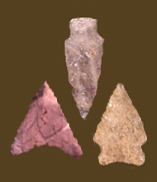
|
PISCATAWAY
Chronology The chronological placement of the Piscataway point is controversial, which is probably due in part to its morphological similarity to the Rossville and other teardrop points. McNett and Gardner (1975) and Dent (1995) place it in the Late Archaic period, based upon its stratigraphic position below other Late Archaic types like the Vernon at various sites along the Potomac and Patuxent rivers. Steponaitis (1980) suggests a date range of 4000 to 3000 BC (approximately 4850-3750 BC in calendar years), while Wanser (1982) prefers 4000 to 3500 BC (roughly 4850-4350 BC in calendar years). Others place it in the Woodland period. At the Pig Point site in Anne Arundel County, Piscataway points were found in Archaic and Early Woodland contexts, the most recent of which was radiocarbon dated to 350 BC, while the oldest was associated with Otter Creek points (Luckenbach et al. 2010; Luckenbach 2014, personal communication). McLearen (1991) suggests the Piscataway appears along the lower Potomac by approximately 900 BC. At the Broad Creek site (18PR131) in Prince George’s County, Piscataway points were often found in association with Early Woodland period Accokeek pottery (Siegel et al. 2004), and they were present mostly in Early Woodland contexts at the Higgins site in Anne Arundel County (Ebright 1992). In southern New Jersey, teardrop points have been found in association with radiocarbon dates ranging from 3430 +/- 250 BP to 2000 +/-85 BP (approximately 1750 BC to 25 AD calendar), with most of the dates falling within the Early Woodland period (Mounier and Martin 1994). Stephenson and Ferguson (1963) place it in the Late Woodland period because of its association with Potomac triangular points and Potomac Creek pottery at the Accokeek Creek site. Overall, the evidence suggests that teardrop-shaped points known as Piscataway and Rossville were used in the Mid-Atlantic region during the Late Archaic and Early Woodland periods, and perhaps later. Blade: The blade is a long and slender triangle with straight or convex edges and a lenticular, often thick, cross section. The edges are occasionally beveled. Haft Element: The base is rounded or pointed. The stem is small and contracting, with an oval cross section. Very weak shoulders separate it from the blade. Size: Length ranges from 29 to 49 mm (and occasionally longer), with an average of 37 mm. Width ranges from 10 to 21 mm, with an average of 14 mm. Thickness ranges from 5 to 10 mm, with an average of 7 mm. Technique of manufacture: Well-made by pressure flaking on all surfaces. Material: In a sample of 577 Piscataway points from the lower Patuxent drainage, Steponaitis (1980) reported that 96% were quartz, followed by quartzite (3%), rhyolite (0.8%), and chert and argillite (0.1% each). In the area surrounding Zekiah Swamp on the lower Potomac, Wanser (1982) found that 78% of 268 Piscataway points were quartz, with 15% quartzite, 5% rhyolite, and small quantities of chert, jasper, and other materials. At the Accokeek Creek site in Prince George’s County, most of the 301 examples were quartz, with rare quartzite and rhyolite specimens (Stephenson and Ferguson 1963). At the Broad Creek site, also in Prince George’s, 96% of the 25 Piscataway points were quartz, with the remainder quartzite (Siegel et al. 2004). In the Monocacy River drainage, 57% of 44 Piscataway points were rhyolite, with 30% quartz, 11% quartzite, and 2% chert (Kavanagh 1982). In the middle Potomac Valley, quartz Piscataway points are most common, but rhyolite and quartzite are sometimes used (Hranicky 2002). Discussion The Piscataway tends to be narrower than the similar Rossville point, with a smaller stem and shoulder. But the relationship between the two types needs to be explored; it is possible that they represent morphological variations within a single type, or that generalized teardrop-shaped points appeared and disappeared at various times in the Late Archaic and Woodland periods. The Piscataway is also reminiscent of the Will’s Cove point, thought to be an Early Woodland type, identified in Virginia by Bottoms (1979). The primary difference is the tapered stem of the Piscataway point versus the square stem of the Will’s Cove. Defined in Literature References |
![]()
Search by Shape:
(See Projectile Point Typology) |

|
Thank you for visiting our website. If you have any
questions, comments, Copyright © 2002 by |

|

 Defining Attributes
Defining Attributes